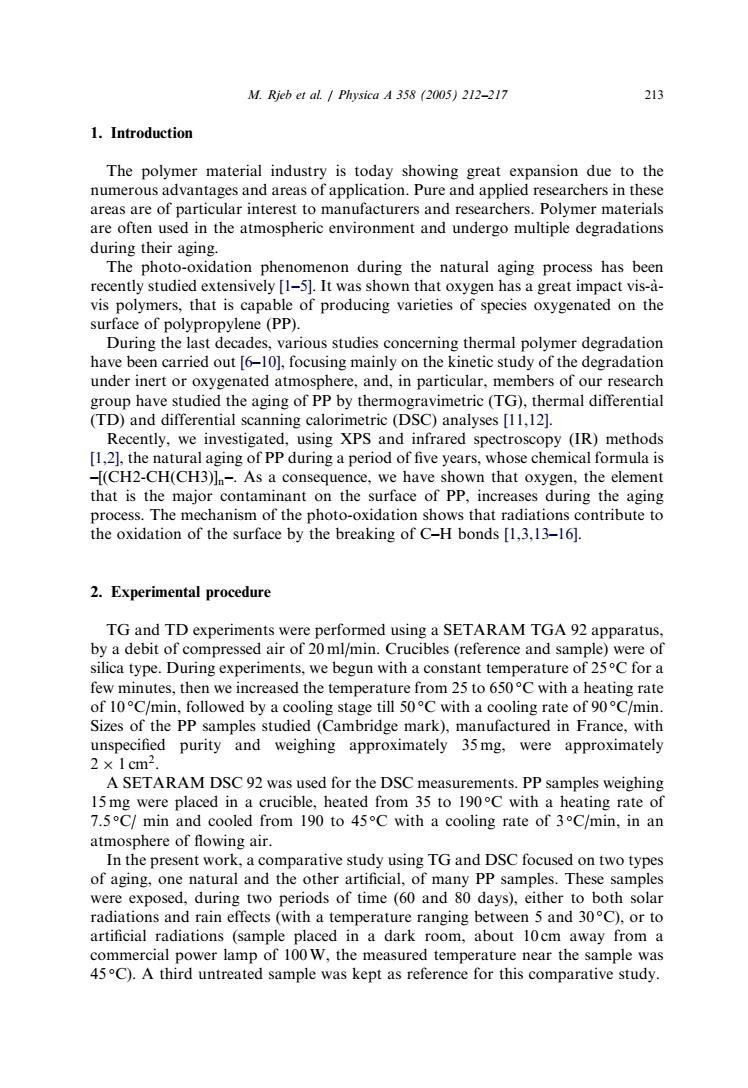正在加载图片...

M.Rjeb et al Physica A358(2005)212-217 213 1.Introduction The polymer material industry is today showing great expansion due to the ion.Pur chers in the area e of nufacture polym are ofter the The photo-oxidation phenomenon during the natural aging process has been recently studied extensively [1-5].It was shown that oxygen has a great impact vis-a- vis polymers,that is capable of producing varieties of species oxygenated on the surface of polypropylene (PP). During the last decades,various studies concerning thermal polymer degradation have been carried out [6-10],focusing mainly on the kinetic study of the degradation under inert or oxygenated atmosphere,and,in particular,members of our research group have studied the aging of PP by thermogravimetric(TG).thermal differential (TD)and differential scanning calorimetric (DSC)analyses [11.121. Recently.we investigated.using xPS and infrared s ectroscopy (IR)methods [1.21,the natural aging of PP during a period of five years.whose chemical formula is (CH2-CH(CH3) As a cons we have that is the on the of PP,incre nng t the aging proces th -0 the oxidation o e surface by th breaking of C-H bonds [1.3.13-16]. 2.Experimental procedure TG and TD experiments were performed using a SETARAM TGA 92 apparatus. by a debit of compressed air of 20 ml/min.Crucibles (reference and sample)were of silica type.During experiments,we begun with a constant temperature of 25C for a few minutes,then we increased the temperature from 25 to 650C with a heating rate of 10C/min.followed by a cooling stage till 50C with a cooling rate of 90C/min Sizes of the PP samples studied (Cambridge mark).manufactured in France.with unspecified purity and weighing approximately 35mg.were approximately 21cm2 A SETARAM DSC 92 was e placedn used for the DSC measure n35 to mples weighing 7.5C nin cooled from 190 to 45C atmosphere of flowing air. In the present work,a comparative study using TG and DSC focused on two types of aging,one natural and the other artificial,of many PP samples.These samples were exposed,during two periods of time (60 and 80 days),either to both solar radiations and rain effects(with a temperature ranging between 5 and 30C),or to artificial radiations (sample placed in a dark room,about 10cm away from a commercial power lamp of 100 W,the measured temperature near the sample was 45C).A third untreated sample was kept as reference for this comparative study. 1. Introduction The polymer material industry is today showing great expansion due to the numerous advantages and areas of application. Pure and applied researchers in these areas are of particular interest to manufacturers and researchers. Polymer materials are often used in the atmospheric environment and undergo multiple degradations during their aging. The photo-oxidation phenomenon during the naturalaging process has been recently studied extensively [1–5]. It was shown that oxygen has a great impact vis-a`- vis polymers, that is capable of producing varieties of species oxygenated on the surface of polypropylene (PP). During the last decades, various studies concerning thermal polymer degradation have been carried out [6–10], focusing mainly on the kinetic study of the degradation under inert or oxygenated atmosphere, and, in particular, members of our research group have studied the aging of PP by thermogravimetric (TG), thermaldifferential (TD) and differential scanning calorimetric (DSC) analyses [11,12]. Recently, we investigated, using XPS and infrared spectroscopy (IR) methods [1,2], the naturalaging of PP during a period of five years, whose chemicalformula is –[(CH2-CH(CH3)]n–. As a consequence, we have shown that oxygen, the element that is the major contaminant on the surface of PP, increases during the aging process. The mechanism of the photo-oxidation shows that radiations contribute to the oxidation of the surface by the breaking of C–H bonds [1,3,13–16]. 2. Experimental procedure TG and TD experiments were performed using a SETARAM TGA 92 apparatus, by a debit of compressed air of 20 ml/min. Crucibles (reference and sample) were of silica type. During experiments, we begun with a constant temperature of 25 C for a few minutes, then we increased the temperature from 25 to 650 C with a heating rate of 10 C/min, followed by a cooling stage till 50 C with a cooling rate of 90 C/min. Sizes of the PP samples studied (Cambridge mark), manufactured in France, with unspecified purity and weighing approximately 35 mg, were approximately 2 1 cm2. A SETARAM DSC 92 was used for the DSC measurements. PP samples weighing 15 mg were placed in a crucible, heated from 35 to 190 C with a heating rate of 7.5 C/ min and cooled from 190 to 45 C with a cooling rate of 3 C/min, in an atmosphere of flowing air. In the present work, a comparative study using TG and DSC focused on two types of aging, one natural and the other artificial, of many PP samples. These samples were exposed, during two periods of time (60 and 80 days), either to both solar radiations and rain effects (with a temperature ranging between 5 and 30 C), or to artificial radiations (sample placed in a dark room, about 10 cm away from a commercialpower lamp of 100 W, the measured temperature near the sample was 45 C). A third untreated sample was kept as reference for this comparative study. ARTICLE IN PRESS M. Rjeb et al. / Physica A 358 (2005) 212–217 213�